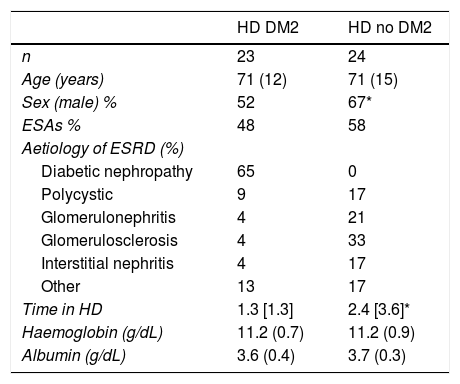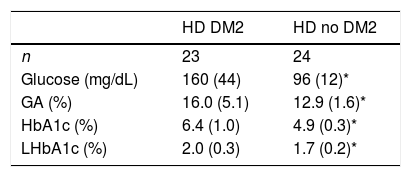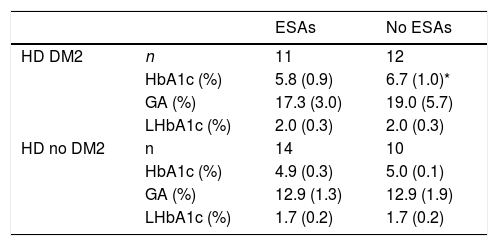Diabetes mellitus (DM) is one of the leading causes of end-stage renal disease. Glycosylated hemoglobin (HbA1c) is the recommended glycemic marker to achieve an optimal glycemic control that is essential to prevent comorbidities associated with the disease. However, in patients on haemodialysis (HD) this marker has important limitations, this reason has led us to search alternative markers such as glycosylated albumin (AG), labile fraction of glycosylated hemoglobin (LHbA1c) or glycation indices.
Patients and methodsWe enrolled 47 patients in HD, 23 with DM, obtaining samples for the determination of de AG, HbA1c y LHbA1c. Glycation indices, which allow estimated the HbA1c using glucose, AG or LHbA1c, were calculated including a control group composed of 75 diabetic patients without kidney disease.
ResultsDiabetic patients in HD had significantly higher mean values than patients without DM for glucose [160 (44) vs 96 (12)mg/dL], HbA1c [6,4 (1,0) vs 4,9 (0,3)%], AG [16,0 (5,1) vs 12,9 (1,6)%] and LHbA1c [2,0 (0,3) vs 1,7 (0,2)%].
HbA1c calculated using glycation indices was significantly higher than measured in all HD patients, regardless of the marker used for the estimation.
ConclusionsThe glycemic markers evaluated (glucose, AG and LHbA1c), could reflect a possible underestimation of the real glycemic state by HbA1c because of the limitations of this marker in HD patients. The use of alternative markers, knowing their limitations, could improve the monitoring of patients on HD and, therefore, reduce the risk of developing DM2 complications.
La diabetes mellitus (DM) es una de las principales causas de enfermedad renal crónica terminal. Un óptimo control glucémico es básico para prevenir las comorbilidades asociadas a la enfermedad, siendo la hemoglobina glicosilada (HbA1c) el marcador glucémico recomendado. No obstante, en pacientes en hemodiálisis (HD) este marcador presenta importantes limitaciones, lo que ha llevado a buscar marcadores alternativos como albúmina glicosilada (AG), fracción lábil de la hemoglobina glicosilada (LHbA1c) o índices de glicación.
Pacientes y métodosSe reclutaron 47 pacientes en HD, 23 con DM, obteniéndose muestras para la determinación de AG, HbA1c y LHbA1c. Los índices de glicación, que permiten estimar el valor de HbA1c mediante glucosa, AG o LHbA1c, se calcularon incluyendo un grupo control compuesto por 75 pacientes diabéticos sin enfermedad renal.
ResultadosLos pacientes diabéticos en HD presentaron valores medios significativamente mayores que los pacientes sin DM para glucosa [160 (44) vs 96 (12)mg/dL], HbA1c [6,4 (1,0) vs 4,9 (0,3)%], AG [16,0 (5,1) vs 12,9 (1,6)%] y LHbA1c [2,0 (0,3) vs 1,7 (0,2)%].
La HbA1c calculada mediante los índices de glicación fue significativamente superior a la medida en todos los pacientes en HD, indistintamente del marcador empleado para su estimación.
ConclusionesLos marcadores glucémicos evaluados (glucosa, AG y LHbA1c) parecen reflejar una posible subestimación del estado glucémico real por la HbA1c debido a las limitaciones que presenta en los pacientes en HD. El uso de marcadores alternativos, teniendo en cuenta también sus limitaciones, podría mejorar el seguimiento de los pacientes en HD y disminuir, por tanto, el riesgo del desarrollo de complicaciones asociadas a DM2.












